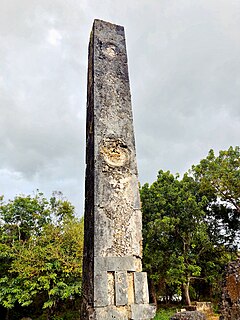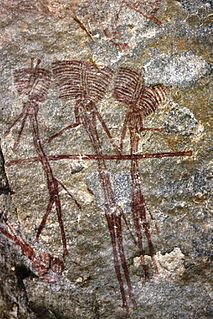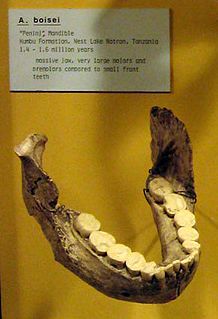
The Olduvai Gorge or Oldupai Gorge in Tanzania is one of the most important paleoanthropological localities in the world; the many sites exposed by the gorge have proven invaluable in furthering understanding of early human evolution. A steep-sided ravine in the Great Rift Valley that stretches across East Africa, it is about 48 km (30 mi) long, and is located in the eastern Serengeti Plains within the Ngorongoro Conservation Area in the Olbalbal ward located in Ngorongoro District of Arusha Region, about 45 kilometres from Laetoli, another important archaeological locality of early human occupation. The British/Kenyan paleoanthropologist-archeologist team of Mary and Louis Leakey established excavation and research programs at Olduvai Gorge that achieved great advances in human knowledge and are world-renowned. The site is registered as one of the National Historic Sites of Tanzania.

The Tongoni Ruins are a 15th century Swahili ruins of a mosque and forty tombs located in Tongoni ward in Tanga District inside Tanga Region of Tanzania. The area was a different place four to five centuries ago. Contrary to its almost unnoticed presence today, it was a prosperous and a respected Swahili trading centre during the 15th century. Most of the ruins are still not yet been uncovered. The site is a registered National Historic Site.

Toten Island is a small uninhabited and protected island situated north of the city of Tanga's harbour in Tanga Region, Tanzania. It is within the Tanga Bay. The island is administered by both the Tanzania Marine Parks and Reserves and the City of Tanga. The island is a historical site that contains ruins of two Medieval Swahili mosques and tombs. The current name comes from the German word for "dead bodies" alluding to the numerous graves on the island. Until 1854 Toten Island was still inhabited by people. In 1884 the remaining people moved to what is present day Tanga city.

The Kondoa Rock-Art Sites or Kondoa Irangi Rock Paintings are a series of ancient paintings on rockshelter walls in central Tanzania. The Kondoa region was declared a UNESCO World Heritage site in 2006 because of its impressive collection of rock art. These sites were named national monuments in 1937 by the Tanzania Antiquities Department. The paintings are located approximately nine kilometres east of the main highway (T5) from Dodoma to Babati, about 20 km north of Kondoa town, in Kondoa District of Dodoma Region, Tanzania. The boundaries of the site are marked by concrete posts. The site is a registered National Historic Sites of Tanzania.
The Bahi Rock-Art Sites or Bahi rock paintings are rock art located at three sites in the Dodoma region of Tanzania. These white paintings are believed to be products of the Wamia people, who occupied the region before the Wagogo people. The paintings, which depict cattle, human figures, stools, gourds, a bird, and an arrow, among other symbols, were supposedly executed during important occasions such as funerals. The Wagogo people, though not fully aware of the original significance of the paintings to the Wamia, have continued to use the sites as sacred locations for rain-making ceremonies. The Bahi paintings are estimated to be at least 340 years old based on the genealogy of the Bahi chief in 1929, which revealed the estimated time of his ancestor Kimanchambogo's arrival in the area. The white painting method is generally associated with Bantu-speaking farming populations.
Amini Aza Mturi was a Tanzanian archaeologist and director of the Tanzanian Division of Antiquities between 1968 and 1981. He has been described as "one of the founding fathers of archaeology in Tanzania".
Vugha or Vuga is historic village located inside Bumbuli District of Tanga Region in Tanzania. The settlement was established as the capital of the Kilindi dynasty.

The Mlambalasi Rock Shelter is a historic site located in Iringa District of Iringa Region in southern Tanzania, 50 km away from Iringa City. Excavations in 2006 and 2010 by the Iringa Region Archaeological Project uncovered artifactual deposits from the Later Stone Age (LSA), the Iron Age, and the historic periods, as well as external artifacts from the Middle Stone Age (MSA). Direct dating on Achatina shell and ostrich eggshell beads indicates that the oldest human burials at Mlambalasi are from the terminal Pleistocene. Mlambalasi is characterized by interment LSA and Iron Age periods, as well as by cycles of use and abandonment.

National Historic Sites of Tanzania is an official list of places in Tanzania that have been designated as National Historic Sites as per the Ministry of Natural Resources and Tourism of Tanzania under the Antiquities Division. The list is not complete and is currently being updated.
Yambe Island is protected, uninhabited historic island located directly east of the city of Tanga in Tanga District of Tanga Region in Tanzania. It is the largest island in Tanga region. It is located entirely with the Tanga Coelacanth Marine Park (TCMP). The island is administered by the Tanzania Marine Parks and Reserves. The island is also home to medieval Swahili ruins that have yet to be excavated.

Pujini Ruins is a Medieval historic site next to the village of Pujini located in Chake Chake District of Pemba South Region. There used to be a fortified palace at the site, only ruins of the walls remain. The palace is believed to have been of Mkame Mdume. Its one of several National Historic Sites on the island of Pemba including Chambani and Ras Mkumbuu.
Shamiani is protected historic site located inside Mkoani District of Pemba South Region in Tanzania. The site is home to partially excavated abandoned medieval Swahili ruins with a brief occupation period from about 14th to 16th century.

Msuka Mjini Ruins is protected historic site located inside Micheweni District of Pemba North Region in Tanzania. Msuka Mjini has a Swahili mosque from the fifteenth century preserved in ruins on the Kigomasha peninsula on the island. The date 816AH is carved on the interior of the circular mirhab.

Peninj is a pre-historic site located in Pinyinyi ward of Ngorongoro District in Arusha Region, Tanzania. This the site where the Peninj Mandible was discovered in 1964.
Mduuni Ruins is protected historic site located inside Micheweni District of Pemba North Region in Tanzania. The settlement was established around 1100 CE.
Mkia wa Ng'ombe Ruins is protected historic site located inside Micheweni District of Pemba North Region in Tanzania. The settlement was established around the 15th CE and abandoned in the 16th century. There are ruins of a mosque, tombs and some stone buildings. The site is critically endangered to further erosion.
Kisimani Mafia is a national historic site located in Mafia District of Pwani Region. They are Mafia's oldest ruins, which are close to Kilindoni. The earliest strata of mosques, according to archaeologist Neville Chittick who performed excavations there in the 1950s, date from about the tenth and eleventh centuries. However, many of them have since been washed into the sea.
Nyabusora is an archaeological site dated to the Stone Age. The site is located in Kagera Region of Tanzania.
Katuruka is an archaeological site dated to the Iron Age. The pottery found in the site appears to be of the Urewe type, which is also found in other regions of the Lake Victoria basin. Additionally, there is proof that advanced iron smelting technology existed in the last few millennia BC. It is the first known instance of ironworking in central and southern Africa. The site is located in Kagera Region of Tanzania.
Bweranyange is historic settlement located inside Karagwe District of Kagera Region in Tanzania. The settlement was established as the capital of the Karagwe Kingdom. The site is a registered National Historic Site.









